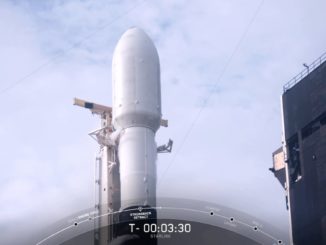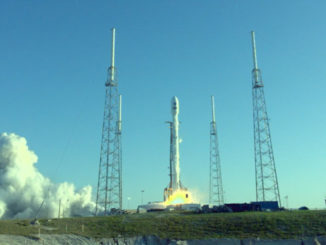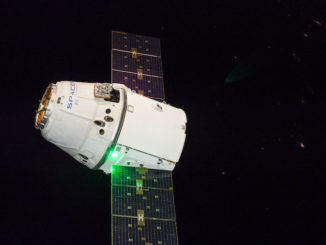SpaceX’s two fast-maneuvering payload fairing recovery vessels were in the right place at the right time Monday to catch both halves of the nose shroud jettisoned by a Falcon 9 rocket climbing into orbit with South Korea’s Anasis 2 military communications satellite.
The California-based launch company released a pair of videos Tuesday on Twitter, showing views from each of the fairing recovery boats as the vessels steered under the shroud shells descending under parachutes around 40 minutes after the Falcon 9’s liftoff from Cape Canaveral.
— SpaceX (@SpaceX) July 21, 2020
The twin recovery ships, named “Ms. Tree” and “Ms. Chief,” were located around 480 miles (775 kilometers) east of Cape Canaveral in the Atlantic Ocean for Monday’s mission.
The Falcon 9 rocket took off from Cape Canaveral at 5:30 p.m. EDT (2130 GMT) Monday with Anasis 2, South Korea’s first dedicated military communications satellite. On the way into orbit, the launcher jettisoned its first stage booster, which descended back to Earth for a pinpoint landing on SpaceX’s drone ship in the Atlantic Ocean.
Moments later, the Falcon 9’s upper stage ignited and then released the two-piece clamshell-like nose cone that shielded the Anasis 2 satellite from aerodynamic forces and airflow during the first few minutes of the flight. By that time, the rocket was flying at an altitude of about 68 miles, or 110 kilometers, above the densest layers of the atmosphere.
The first stage maneuvered back to Earth using a series of propulsive burns of its main engines, allowing it to target touchdown on the SpaceX landing platform. The booster was making its second launch after its first use helped launch NASA astronauts aboard SpaceX’s Crew Dragon spacecraft May 30.
The re-flight of the first stage Monday — 51 days after its May 30 mission — marked the shortest turnaround between flights of a Falcon 9 booster.
The Falcon 9’s fairing shells come back to Earth in a more unguided fashion, using cold gas thrusters to orient themselves for deployment of a steerable parachute, or parafoil, to slow down before reaching the ocean.
The fairing recovery boats are each equipped with a giant net to catch the falling fairing halves. SpaceX has caught one fairing shell on prior missions — and plucked the other half from the ocean — but Monday’s achievement was the first time the company has netted both pieces of the fairing on the same launch.
Catching the fairing with the net helps reduce contamination from sea water, easing refurbishment of the nose cone for reuse on future flights.

The company wants to more regularly reuse the fairing, eyeing it as the next step in reducing launch costs after proving the landing and reuse of Falcon booster stages. The fairing shells flown on Monday’s mission were brand new.
The Falcon 9’s fairing stands about 43 feet (13.1 meters) tall and measures about 17 feet (5.2 meters) in diameter.
SpaceX reused a fairing for the first time on a Falcon 9 launch last November carrying 60 of the company’s own Starlink broadband satellites into orbit. The company has since repeated the feat.
Other launch providers dispose of the fairing, but SpaceX began using a fast-moving boat to steer underneath a fairing following launches from California in early 2018. The efforts chalked up a series of near-misses, prompting engineers to evaluate reusing fairings that fell into the sea.
SpaceX has since added a second fairing recovery vessel to its fleet, and moved the fairing-catching boats to Florida, where the company has a higher launch rate.
The first fairing that SpaceX reused last November was retrieved from the ocean after a Falcon Heavy launch in April 2019.
Elon Musk, SpaceX’s founder and CEO, told reporters in 2018 that each new fairing costs around $6 million.
Email the author.
Follow Stephen Clark on Twitter: @StephenClark1.



